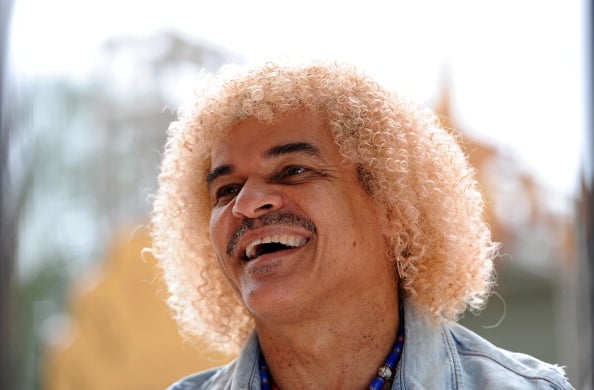What is Carlos Valderrama's Net Worth?
Carlos Valderrama is a Colombian retired professional soccer player who has a net worth of $10 million. Widely regarded as one of the most iconic figures in South American football, Carlos Valderrama built a career defined by his vision, precise passing, and flamboyant personality. Known for his trademark blond afro and commanding presence in midfield, he played in three FIFA World Cups and was a key figure for the Colombian national team during its 1990s golden era. Over nearly two decades, Valderrama became one of the best playmakers of his generation, with a club career spanning Colombia, France, Spain, and Major League Soccer in the United States. After retiring in 2002, he remained a cultural icon, remembered not only for his contributions on the field but also for his larger-than-life charisma that made him a global ambassador for the game.
Early Life
Carlos Alberto Valderrama Palacio was born on September 2, 1961, in Santa Marta, Colombia. Growing up on Colombia's Caribbean coast, he was immersed in the country's rich soccer culture from an early age. His natural flair for the game was evident in his youth, and he quickly rose through local clubs before joining Unión Magdalena in the early 1980s. His playmaking skills and vision in midfield distinguished him from his peers and set the foundation for his professional career.
Club Career
Valderrama began his professional career with Unión Magdalena in 1981 before moving to Millonarios and then Deportivo Cali, where he further established himself as one of Colombia's most talented midfielders. His performances attracted interest from abroad, and in 1988 he signed with Montpellier in France. During his time there, he helped the club win the 1990 French Cup, proving that his South American flair could adapt to European football.
He later played in Spain with Real Valladolid before returning to Colombia in the early 1990s. Valderrama eventually became one of the first global stars to join Major League Soccer when he signed with the Tampa Bay Mutiny in 1996. His arrival was a major coup for MLS, which was just getting started at the time. Valderrama went on to play for the Miami Fusion and Colorado Rapids, becoming one of the league's early icons. He retired in 2002 with a reputation as one of the most technically gifted players to ever grace MLS.

(Photo by Valerio Pennicino/Getty Images for Golden Foot)
International Career
Valderrama's greatest legacy may be his time with the Colombian national team. He earned 111 caps between 1985 and 1998, making him one of the most capped players in Colombian history. Known for his leadership and calm presence on the ball, he was the heartbeat of the national team during its resurgence in the late 1980s and 1990s.
He played in three consecutive FIFA World Cups (1990, 1994, and 1998). The 1990 tournament in Italy was particularly memorable, as Valderrama led Colombia to the Round of 16, their best performance at the time. His exquisite passing, particularly an assist to Freddy Rincón in the famous match against West Germany, remains one of the defining moments of Colombian soccer history.
Style and Legacy
Nicknamed "El Pibe," Valderrama was celebrated not for speed or scoring but for his unrivaled vision and ability to control the tempo of the game. He was a true midfield general, dictating play with short, precise passes and his ability to create chances seemingly out of nothing. His iconic blond afro became one of the most recognizable images in world soccer, making him as much a cultural figure as a sporting one.
Valderrama's legacy is deeply tied to Colombia's golden generation of the 1990s, a period that lifted the country's footballing profile on the global stage. Even after retirement, his influence continues, with statues and tributes in his honor in Colombia. He has also served as a mentor and youth ambassador, promoting the sport to younger generations.
Life After Football
Since retiring, Valderrama has remained an enduring symbol of Colombian football. He has taken on ambassadorial roles for the sport, participated in charity matches, and occasionally appeared as a television commentator. His likeness is immortalized in statues, and his image continues to represent the joyful, creative spirit of South American soccer.
/2014/07/Carlos-Valderrama-1.jpg)
/2014/06/GettyImages-901282894.jpg)
/2014/06/GettyImages-450871526.jpg)
/2014/06/GettyImages-488179468.jpg)
/2014/06/GettyImages-884455958.jpg)
/2014/06/GettyImages-108364564-e1738719376122.jpg)
/2009/09/Cristiano-Ronaldo.jpg)
/2019/11/GettyImages-1094653148.jpg)
/2020/06/taylor.png)
/2019/10/denzel-washington-1.jpg)
/2009/11/George-Clooney.jpg)
/2019/04/rr.jpg)
/2020/02/Angelina-Jolie.png)
/2009/09/Brad-Pitt.jpg)
/2017/02/GettyImages-528215436.jpg)
/2020/01/lopez3.jpg)
/2020/04/Megan-Fox.jpg)
/2014/07/Carlos-Valderrama-1.jpg)
/2014/06/GettyImages-108364564-e1738719376122.jpg)
/2014/06/GettyImages-901282894.jpg)
/2014/08/GettyImages-175747819.jpg)
/2014/08/Franz-Beckenbauer.png)
/2014/06/GettyImages-884455958.jpg)
/2014/06/GettyImages-461821595.jpg)
/2010/03/Freddy-Adu.jpg)
:strip_exif()/2015/09/GettyImages-476575299.jpg)
:strip_exif()/2009/09/P-Diddy.jpg)
/2009/09/Jennifer-Aniston.jpg)